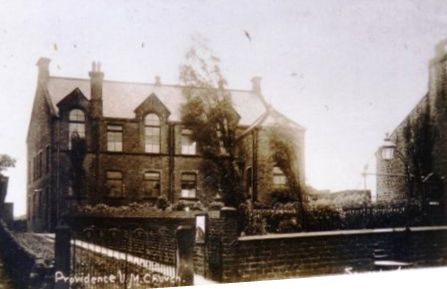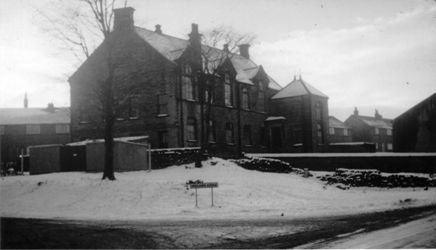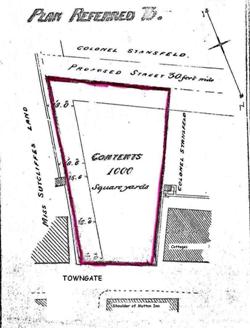
Providence United Methodist Church

In "The History of Sowerby Methodism" covering Rooley lane Wesleyan Methodist Church, it is recorded that among the Items listed on 11th July 1815 for the use of the school and scholars was "Ale for scholars". The occasional supplies of beer mentioned for the scholars seem regrettable, when viewed nowadays, but possibly it was safer than drinking their piped/well water.
The temperance movement started during the early years of the 19th century with widespread alcohol abuse and general drunkenness among the working classes. The "movement" promoting moderation or total abstinence from the use of alcohol started in Britain around 1826, and societies were set up to rescue those whose lives had been blighted by the demon drink.
The next step came in 1847 when a 72 year old Irishman was invited to speak to a children's meeting in Leeds. Anne Jane Carlisle one of the organizers was convinced that children suffered because of the ready availability of "strong drink". She met a young Baptist minister, Jabez Tunnicliffe who had been badly shaken by a dying alcoholic, who grabbed him and made him promise to warn children of the dangers of drink.
The "Band of Hope", a temperance organization for working-class children, was founded in Leeds in 1847. All members took a pledge of total abstinence and were taught the "evils of drink". Members were enrolled from the age of six and met once a week to listen to lectures and participate in activities.
On the Jubilee of the Church in 1926 a small booklet was produced with a short history of the Church this history is based on a small part of that publication.

In the following January a Temperance Love Feast was held at which 79 were present. On 29th July 1871 a large contingent went to Hebden Bridge, to take part in a demonstration, and in the same year they joined the Tuel Lane Band of Hope in a demonstration held in the Sowerby Bridge Town Hall. The building was packed, and the enthusiasm of the meeting created a deep impression. In October of the same year they joined the Halifax Band of Hope Union.
In 1874 they turned out in full strength, and paraded the town with a banner with "Band of Hope" on the front and "Save the Children" on the back.
In course of time, it became more and more evident to the leaders that serious impediments were being placed in the way of the free spread of Temperance principles, and earnest and serious discussions took place between the advocates and their opponents. It became quite clear that unless the opposition became less pronounced, the Temperance party might be driven to sever the tie that bound them to the Church of their fathers, a step which they were most reluctant to take, and yet they were in no mood to sacrifice their principles. The crisis came when the opponents, on 29th March 1875, succeeded in carrying out a resolution in the trustees meeting, prohibiting the future holding of any Temperance meeting on the premises.
The Temperance party, which included officers of the Church and Sunday school, immediately sent in their resignation, and decided to find a new home, where they could have free scope to advocate their temperance principles. On 2nd April they met to consider what steps should be taken. Among other things they decided to devote the funds of the Band of Hope and lodge to secure a new home. At a subsequent meeting, it was resolved "that we come to the next meeting, to be held on 21st April prepared to say how much we are prepared to subscribe". The meeting was held, and it was decide as a first step to hire "the Weaver's Shed" (commonly known as "Gallis Hoil", at Pinfold Green, now turned into cottages), in which to carry on the work which lay so dear to their hearts. All this took place in the church when the temperance movement was far from popular.
As soon as the decision was reached to hire the Gallis Hoil at a rental of 2/- per week, the friends set to work with a will to get the place in order. For the next fortnight it was a veritable hive of industry, for a good deal had to be done in the way of cleaning, whitewashing, scrubbing and securing forms, etc., before the building could be made presentable. This led to the first service on Sunday 9th May with the minister, Mr. Henry Hibbert of Bradford preaching to a large congregation, the collection for the day amounting to £21, quite a noteworthy achievement in those days.

Not wishing to have two Societies in Sowerby, the Wesleyan circuit declined to recognize the infant Church. Consequently they offered themselves to the Free Methodist Church in Tuel Lane, and were at once accepted. The first minister was Rev Jabez Percival who stayed for about four years.
At 3.00pm on Saturday 2nd October 1875 about two hundred people met outside Gallis Hoil and, forming a procession, marched to the site of the new Church in Towngate. Mr Job Sharp presented a silver trowel and mallet to Councillor Priestman, who laid the cornerstone; other Silver trowels were presented to Mrs Waite and Mrs Edmondson after laying Memorial stones. The ceremony being over, the procession re-formed and marched back to Gallis Hoil where over two hundred sat down to tea.
As an indication of the attitude of the other two Churches in Sowerby, neither of them would allow their premises to be used for the evening meeting, and so, after tea, for a third time the procession was re-formed , this time to march to Sowerby Bridge, where the Town Hall was filled.
To counteract any unpleasant incidents which sometimes followed the holding of funeral teas at Public Houses, the trustees decided to loan their premises at a charge of 2/6, they also decided to hold temperance meetings at least once a week, and they also stipulated that the Minister must be a total abstainer.
The building of the Church, with fixtures cost £1600 and was opened for public worship on Sunday 19th March 1876. In 1892 the premises were declared free from debt to the delight of all the workers. After a further six years it was obvious that the school accommodation had become too small so a new extension was added at a cost of £466.
It is interesting to note that an application on behalf of the Radical party to hold a political meeting was turned down on the grounds that Churches should stay aloof from party politics.
A few dates:
- 1893/95 Two harmonium's were replaced with a new organ £240 plus alterations at £35
- 1893 Faulty ventilation (from the beginning) improved, plus decorating £60
- 1902 New bible stand presented
- 1903 New boiler for heating apparatus installed £16 7s
- 1906 Painted and decorated £58 10s
- 1909 An assembly hall was built along with conveniences at a cost of £108
- 1909 A new communion rail added £18
- c1919 A house for the caretaker £230, numbers 27 and 31 Towngate made into a through house, (Haigh's buildings?) £230.
For the location please see the main village photograph
By John Kerridge